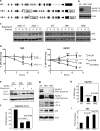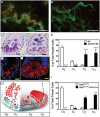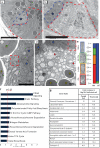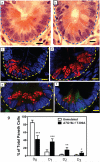A key role for autophagy and the autophagy gene Atg16l1 in mouse and human intestinal Paneth cells
- PMID: 18849966
- PMCID: PMC2695978
- DOI: 10.1038/nature07416
A key role for autophagy and the autophagy gene Atg16l1 in mouse and human intestinal Paneth cells
Abstract
Susceptibility to Crohn's disease, a complex inflammatory disease involving the small intestine, is controlled by over 30 loci. One Crohn's disease risk allele is in ATG16L1, a gene homologous to the essential yeast autophagy gene ATG16 (ref. 2). It is not known how ATG16L1 or autophagy contributes to intestinal biology or Crohn's disease pathogenesis. To address these questions, we generated and characterized mice that are hypomorphic for ATG16L1 protein expression, and validated conclusions on the basis of studies in these mice by analysing intestinal tissues that we collected from Crohn's disease patients carrying the Crohn's disease risk allele of ATG16L1. Here we show that ATG16L1 is a bona fide autophagy protein. Within the ileal epithelium, both ATG16L1 and a second essential autophagy protein ATG5 are selectively important for the biology of the Paneth cell, a specialized epithelial cell that functions in part by secretion of granule contents containing antimicrobial peptides and other proteins that alter the intestinal environment. ATG16L1- and ATG5-deficient Paneth cells exhibited notable abnormalities in the granule exocytosis pathway. In addition, transcriptional analysis revealed an unexpected gain of function specific to ATG16L1-deficient Paneth cells including increased expression of genes involved in peroxisome proliferator-activated receptor (PPAR) signalling and lipid metabolism, of acute phase reactants and of two adipocytokines, leptin and adiponectin, known to directly influence intestinal injury responses. Importantly, Crohn's disease patients homozygous for the ATG16L1 Crohn's disease risk allele displayed Paneth cell granule abnormalities similar to those observed in autophagy-protein-deficient mice and expressed increased levels of leptin protein. Thus, ATG16L1, and probably the process of autophagy, have a role within the intestinal epithelium of mice and Crohn's disease patients by selective effects on the cell biology and specialized regulatory properties of Paneth cells.
Figures




Comment in
-
Defects in autophagy induce alterations in the secretory pathway and proinflammatory signaling of paneth cells.Gastroenterology. 2009 Oct;137(4):1527-9. doi: 10.1053/j.gastro.2009.08.021. Epub 2009 Aug 28. Gastroenterology. 2009. PMID: 19717131 No abstract available.
References
-
- Mizushima N, et al. Mouse Apg16L, a novel WD-repeat protein, targets to the autophagic isolation membrane with the Apg12-Apg5 conjugate. J. Cell Sci. 2003;116:1679–1688. - PubMed
-
- Ouellette AJ. Paneth cell alpha-defensin synthesis and function. Curr. Top. Microbiol. Immunol. 2006;306:1–25. - PubMed
-
- Barbier M, et al. Overexpression of leptin mRNA in mesenteric adipose tissue in inflammatory bowel diseases. Gastroenterol. Clin. Biol. 2003;27:987–991. - PubMed
Publication types
MeSH terms
Substances
Associated data
- Actions
- Actions
- Actions
- Actions
- Actions
Grants and funding
LinkOut - more resources
Full Text Sources
Other Literature Sources
Medical
Molecular Biology Databases

